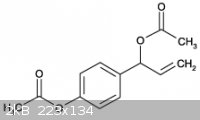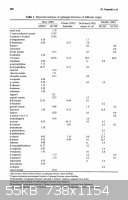Paddywhacker
Hazard to Others
  
Posts: 478
Registered: 28-2-2009
Member Is Offline
Mood: No Mood
|
|
structure of galangol (alpinol)
I have inherited a number of packets of Sha Jiang Fen (galangal) powder, but haven't been able to find out much about it's constituents except that it
contains galangol, also known as alpinol.
Neither of these names are in Chemspider, and Google is not much help, either.
The spice powder has a numbing, anesthetic effect on the tongue which is not to my liking for culinary purposes, so extracting the active ingredients
might be of greater interest, if I only knew what they were.
Can anybody help?
|
|
|
Bot0nist
International Hazard
    
Posts: 1559
Registered: 15-2-2011
Location: Right behind you.
Member Is Offline
Mood: Streching my cotyledons.
|
|
The only thing I could find on "alpinol" was Propranolol and alprazolam capsules. Hardly a culinary spice I would think. More like Indian Xanax...
http://www.indiamart.com/brenstem-bio-sciences/pharmaceutica...
http://en.wikipedia.org/wiki/Alprazolam
http://en.wikipedia.org/wiki/Propranolol
U.T.F.S.E. and learn the joys of autodidacticism!
Don't judge each day only by the harvest you reap, but also by the seeds you sow.
|
|
|
Paddywhacker
Hazard to Others
  
Posts: 478
Registered: 28-2-2009
Member Is Offline
Mood: No Mood
|
|
Alpinol (galangol) is a constituent in galangal spice, also known as Sha Jiang Fen.
|
|
|
arsphenamine
Hazard to Others
  
Posts: 236
Registered: 12-8-2010
Location: I smell horses, Maryland, USA
Member Is Offline
Mood: No Mood
|
|
Google's Scholar search is more helpful in these kinds of searches.
Many papers concentrate on galangal extract medicinal properties but a few cite 1'-acetoxychavicol acetate (CAS: 52946-22-2) as a 2/3 to 3/4
predominant specie in ethanol extracts.

An unencumbered document is available from the original authors.
Antimicrobial properties and action of galangal (Alpinia galanga Linn.) on Staphylococcus aureus
Jirawan Oonmetta-areea, Tomoko Suzukib, Piyawan Gasalucka, Griangsak Eumkebc
http://dx.doi.org/10.1016/j.lwt.2005.06.015
|
|
|
Paddywhacker
Hazard to Others
  
Posts: 478
Registered: 28-2-2009
Member Is Offline
Mood: No Mood
|
|
Thanks very much. That was unexpected. As galangal is the powdered root of a member of the ginger family I had expected the active ingredient to be
similar to zingerone. This is quite different.
|
|
|
Nicodem
Super Moderator
      
Posts: 4230
Registered: 28-12-2004
Member Is Offline
Mood: No Mood
|
|
That is not galangol. Galangol is a flavone, check its structure!
|
|
|
arsphenamine
Hazard to Others
  
Posts: 236
Registered: 12-8-2010
Location: I smell horses, Maryland, USA
Member Is Offline
Mood: No Mood
|
|
Cites, plz.
While alpinia galanga contains dozens of terpenes, both free and bound as glycosides, the "pungent principal", 1'-acetylchavicol acetate, is
most germane and the most often cited. Terpenoids predominate in leaf extracts. Select citations for root or 'rhizome'
extracts, particularly since the root is what we like to eat in Thai food.
The paper cited above uses a polar extract (ethanol) rather than steam distillation since the pungent principal is prone to rearrangement.
Another paper is explicit about the principal's gustatory effect and sigmatropic rearrangement in aqueous media.
Pungent Principal of Alpinia galangal (L.) Swartz and Its Applications
J. Agric. Food Chem., 1999, 47 (4), pp 1657–1662
DOI: 10.1021/jf9808224
Springer-Link gives you a definitive answer in this table image from Flavor Chemicals with Pungent Properties, page 200, DOI:
10.1007/978-1-4615-4693-1_18

|
|
|
Nicodem
Super Moderator
      
Posts: 4230
Registered: 28-12-2004
Member Is Offline
Mood: No Mood
|
|
I made a mistake. I confused galangol with galangin which is a flavone isolated from Alpinia galanga and some other plants.
SciFinder does not list galangol as a compound. Paddywhacker, what is the reference claiming this compound name? Are you sure it is not misspelled?
One database that lists galangol as a constituent of the rhizome of Alpinia galanga and Alpinia officinarum is Dr. Duke's Phytochemical and Ethnobotanical Databases. As is common with this database, it gives a secondary source as a reference: List, P.H. and
Horhammer, L., Hager's Handbuch der Pharmazeutischen Praxis, Vols. 2-6, Springer-Verlag, Berlin, 1969-1979.
It also cites the same reference for the presence of galangin in the the rhizome. Galangin is also present in A. officinarum, Acorus calamus,
Glycyrrhiza glabra, Origanum vulgare and Populus tacamahacca.
I find this "galangol" a bit suspicious. It pretty much sounds like a German transliteration of galangin. I would not be surprised if the seminal
article describing the isolation and characterization of galangin (supposedly done in the year 1881) was in German and the original name was galangol.
A review of the phytopharmacology and phytochemistry of Alpinia galanga can be found in the Indian Journal of Natural Products and Resources, 1 (2010) 143-149. It also mentions no constituent called galangol. No alpinol either,
but it does mention alpinin.
…there is a human touch of the cultist “believer” in every theorist that he must struggle against as being
unworthy of the scientist. Some of the greatest men of science have publicly repudiated a theory which earlier they hotly defended. In this lies their
scientific temper, not in the scientific defense of the theory. - Weston La Barre (Ghost Dance, 1972)
Read the The ScienceMadness Guidelines!
|
|
|
arsphenamine
Hazard to Others
  
Posts: 236
Registered: 12-8-2010
Location: I smell horses, Maryland, USA
Member Is Offline
Mood: No Mood
|
|
Me too.
Simply, it is complicated.
As you examine the available citations, you understand that while there may be a major components, that it is not only the carrots that make the stew.
As a metaphor, I note that strawberries and cilantro leaf have a few common fragrance notes, and that one is complimented by a small amount of the
other, except for those who are sensitive to the C8-C10 α-β unsaturated aldehydes of the latter.
Yes, there are flavinoids in galangal root. I am too lazy to post cites at the moment. Surely someone else can do better.
|
|
|
Paddywhacker
Hazard to Others
  
Posts: 478
Registered: 28-2-2009
Member Is Offline
Mood: No Mood
|
|
Thanks for the feedback. It looks as if galangol and alpinol are archaic names for the mixed resin - "The resin causing the pungent taste (formerly
called galangol or alpinol) consists of several diarylheptanoids and phenylalkanones (the latter are also found in ginger and grains of paradise)"
from here.
|
|
|